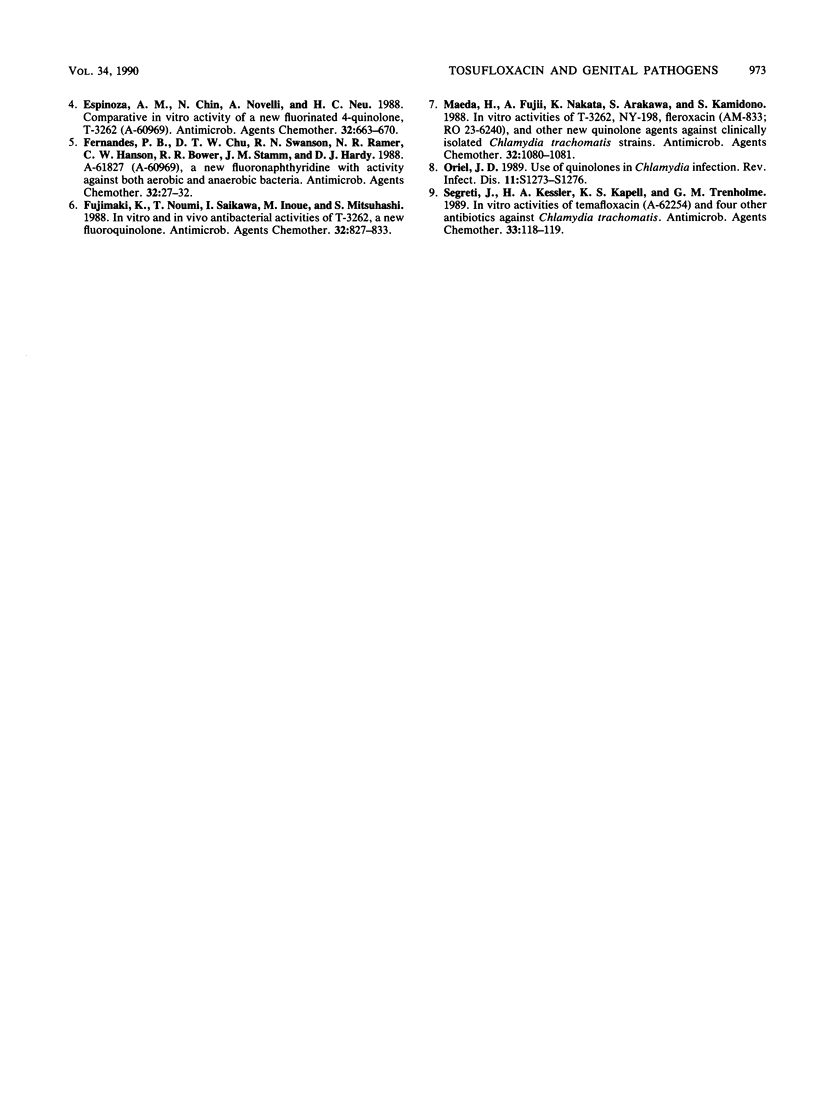Abstract
The in vitro activity of tosufloxacin (A-61827; T-3262) against 15 clinical isolates of Chlamydia trachomatis and 31 recent clinical isolates of Neisseria gonorrhoeae, including 15 spectinomycin-resistant N. gonorrhoeae and 16 penicillinase-producing N. gonorrhoeae, was determined. Tosufloxacin was compared with doxycycline, ciprofloxacin, and temafloxacin against C. trachomatis. Susceptibility testing was performed by using McCoy cell monolayers. The in vitro activity of tosufloxacin against N. gonorrhoeae was compared with that of ciprofloxacin, temafloxacin, doxycycline, ceftriaxone, and spectinomycin by using an agar dilution method. Tosufloxacin was as active as temafloxacin against C. trachomatis (MIC for 90% of strains tested [MIC90], 0.25 microgram/ml; MBC for 90% of strains tested [MBC90], 0.25 microgram/ml) and was almost as active as doxycycline (MIC90, 0.06 microgram/ml; MBC90, 0.125 microgram/ml). Ciprofloxacin, temafloxacin, and tosufloxacin were extremely active against N. gonorrhoeae, including spectinomycin-resistant N. gonorrhoeae and penicillinase-producing N. gonorrhoeae, with MIC90s of 0.004, 0.015, and 0.008 microgram/ml, respectively. Ceftriaxone was slightly less active (MIC90, 0.03 microgram/ml), and doxycycline was the least active drug tested (MIC90, 4.0 micrograms/ml). Tosufloxacin and temafloxacin had excellent activity against the C. trachomatis and N. gonorrhoeae strains tested.
Full text
PDF


Selected References
These references are in PubMed. This may not be the complete list of references from this article.
- Barry A. L., Jones R. N. In-vitro activities of temafloxacin, tosufloxacin (A-61827) and five other fluoroquinolone agents. J Antimicrob Chemother. 1989 Apr;23(4):527–535. doi: 10.1093/jac/23.4.527. [DOI] [PubMed] [Google Scholar]
- Boslego J. W., Tramont E. C., Takafuji E. T., Diniega B. M., Mitchell B. S., Small J. W., Khan W. N., Stein D. C. Effect of spectinomycin use on the prevalence of spectinomycin-resistant and of penicillinase-producing Neisseria gonorrhoeae. N Engl J Med. 1987 Jul 30;317(5):272–278. doi: 10.1056/NEJM198707303170504. [DOI] [PubMed] [Google Scholar]
- Espinoza A. M., Chin N. X., Novelli A., Neu H. C. Comparative in vitro activity of a new fluorinated 4-quinolone, T-3262 (A-60969). Antimicrob Agents Chemother. 1988 May;32(5):663–670. doi: 10.1128/aac.32.5.663. [DOI] [PMC free article] [PubMed] [Google Scholar]
- Fernandes P. B., Chu D. T., Swanson R. N., Ramer N. R., Hanson C. W., Bower R. R., Stamm J. M., Hardy D. J. A-61827 (A-60969), a new fluoronaphthyridine with activity against both aerobic and anaerobic bacteria. Antimicrob Agents Chemother. 1988 Jan;32(1):27–32. doi: 10.1128/aac.32.1.27. [DOI] [PMC free article] [PubMed] [Google Scholar]
- Fujimaki K., Noumi T., Saikawa I., Inoue M., Mitsuhashi S. In vitro and in vivo antibacterial activities of T-3262, a new fluoroquinolone. Antimicrob Agents Chemother. 1988 Jun;32(6):827–833. doi: 10.1128/aac.32.6.827. [DOI] [PMC free article] [PubMed] [Google Scholar]
- Maeda H., Fujii A., Nakata K., Arakawa S., Kamidono S. In vitro activities of T-3262, NY-198, fleroxacin (AM-833; RO 23-6240), and other new quinolone agents against clinically isolated Chlamydia trachomatis strains. Antimicrob Agents Chemother. 1988 Jul;32(7):1080–1081. doi: 10.1128/aac.32.7.1080. [DOI] [PMC free article] [PubMed] [Google Scholar]
- Oriel J. D. Use of quinolones in chlamydial infection. Rev Infect Dis. 1989 Jul-Aug;11 (Suppl 5):S1273–S1276. doi: 10.1093/clinids/11.supplement_5.s1273. [DOI] [PubMed] [Google Scholar]
- Segreti J., Kessler H. A., Kapell K. S., Trenholme G. M. In vitro activities of temafloxacin (A-62254) and four other antibiotics against Chlamydia trachomatis. Antimicrob Agents Chemother. 1989 Jan;33(1):118–119. doi: 10.1128/aac.33.1.118. [DOI] [PMC free article] [PubMed] [Google Scholar]


